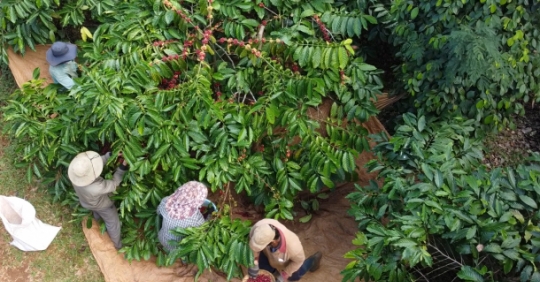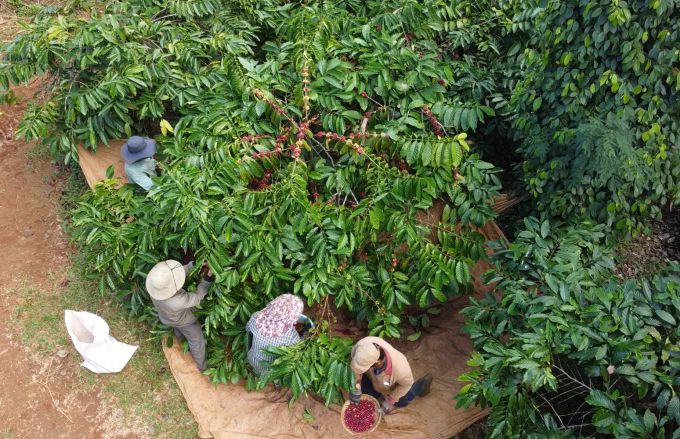
The areas of reclaimed coffee, combined with the application of biological, ecological and sustainable production methods, bring remarkable results. Picture: Minh Qui.
The Institute of Agricultural Planning and Design and the Ministry of Crop Production (MARD) in cooperation with the provinces of the central highlands have just organized a workshop on the development of the project “Development of important industrial crops by 2030”.
The aim of the workshop was to collect comments from managers, scientists, experts and enterprises involved in the production, processing and export of agricultural products to prepare the report “The Current Status and Development Orientation of Rubber Trees”, Coffee, Pepper and Cashew Trees to to be completed in 2030. .
High productivity but still “snapping” style
Vietnam’s coffee-growing area will reach 709,000 hectares in 2022, an increase of 1.21 times compared to 2012. The average growth rate in the period 2011-2022 will reach over 2%/year. The average productivity of the whole country will reach 29 quintals/ha in 2022, which is an increase of 1.24 times compared to 2011. Production will increase from 1.277 million tons in 2011 to 1,886 million tons in 2022.
According to Mr. Le Ba Hoai, an expert from the Institute of Agricultural Planning and Design, the acreage for over 15-year-old coffee in the central highlands is currently over 132,000 hectares, which accounts for over 50% of the area of the area. In particular, Dak Lak has the largest proportion of old, underperforming coffee gardens in the country. In the case of coffee and tea, more than 27% is accounted for by the old area.
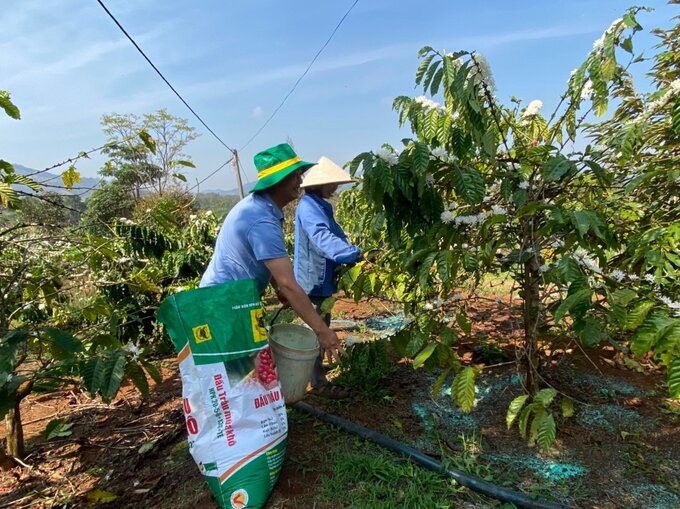
The abuse of chemical fertilizers in coffee production in the central highlands makes the production of this commodity extremely unsustainable. Picture: MQ.
At present, coffee is one of the industrial crops with high economic value and makes an important contribution to people’s income as well as Vietnam’s export turnover. However, coffee products in Vietnam still have many shortcomings, such as: Mainly raw processing, small proportion of deep-processed and refined products; Networking and development cooperation along the value chain are still weak; Geographical indications, brand development, brand protection and international intellectual property for coffee products were not the focus. The application of 4.0 technology in production still faces many difficulties and the coffee industry faces competition from many countries such as Brazil, Laos and West African countries, East Africa…
Voi coffee, tea coffee and jackfruit coffee are mainly grown in Vietnam. To date, the authorities have issued four Geographical Indications for coffee products. In particular, in Lam Dong, 11,000 hectares are being tested to serve sustainable development towards improving quality, added value and food safety, and issuing area codes.
The application of information technology and technology 4.0 to coffee production has just stopped at a pilot model in Di Linh (Lam Dong) district. Building an automatic weather monitoring system through the Internet using science and technology is still difficult…
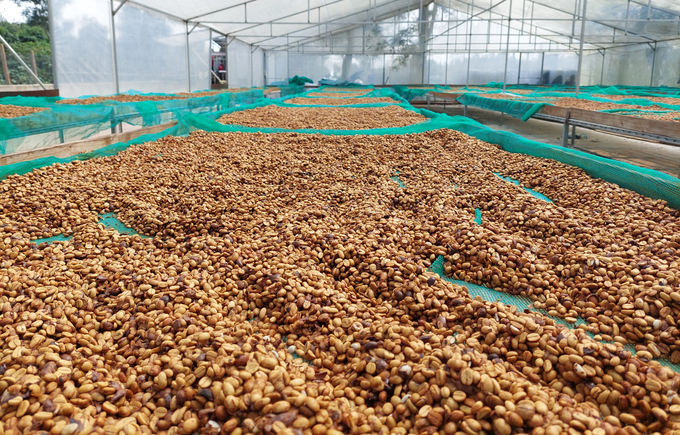
Currently, Vietnamese coffee focuses only on raw processing and not specialty products. Picture: Minh Qui.
At present, the coffee development situation is fragmented, spontaneous, unplanned, low investment, not high quality and cleanliness are still common. In addition, the orchard is small, so it is very difficult to apply technical measures of intensive agriculture, plant protection and product collection in accordance with modern technology.
The tendency to exploit and exploit orchards by abusing chemical fertilizers, growth stimulants and pesticides in an overdose to obtain immediate yield and yield, but then quickly wear off, making gardening efficiency more effective. Poor and unsustainable economic results.
The situation of spontaneous purchase, sale, lien and transfer of orchard land as well as forest burning for coffee and rubber plantations has become popular and threatens the sustainable development of many perennial industrial orchards. , which has a major impact on the environment, the irrigation water sources, ecology. Production is not linked to processing and consumption. Most of the industrial perennial crops in our country do not have high-quality processing plants and advanced machinery, so the exported products are mainly raw or pre-processed materials with poor quality and price. livery.
BILLIONFocus on replanting old coffee
Thanks to the preferential export tariffs on processed coffee, many companies have started to pay attention and focus on investing in this area. Since then, companies have contributed to increasing the added value of the products and the export sales of the entire industry. Coffee is one of 39 Geographical Indications of Vietnam mandated by the EU to protect. This is the competitive advantage of Vietnamese coffee over the competition in the EU market.
According to Ms. Cao Phuong Nhung (Institute of Agricultural Planning and Design), to date (in 2022), the coffee-growing area in our country has reached 709,000 hectares, which is an increase of 1.42 times compared to the approved plan in 2018. 2012. This messed up planning and severely impacted the productivity, quality and value of Vietnamese coffee.
Therefore, in the period up to 2030, Vietnam will not develop new cultivation areas, but will only develop areas based on particularly suitable natural and socio-economic conditions, based on the renewal of existing coffee gardens and the new planting of coffee for old, low-yield areas.
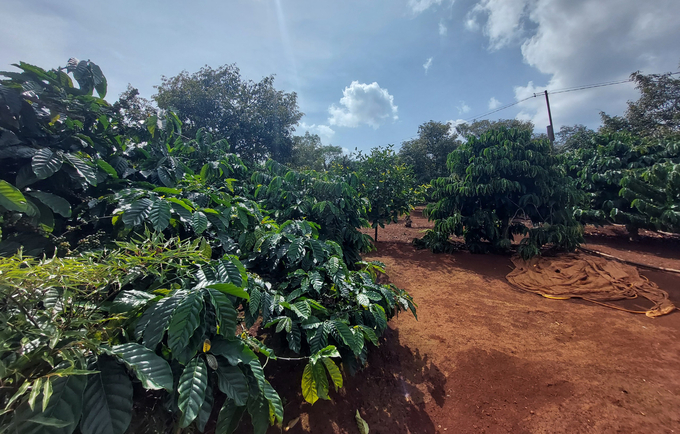
Vietnam needs to focus on replanting old coffee gardens in the near future instead of increasing the area. Picture: Minh Qui.
To support the development of Vietnam’s coffee industry, all levels and sectors have numerous supporting mechanisms and policies in place, most notably the 10-year Socio-Economic Development Strategy for 2021-2030.
Specifically: support for tax incentives, land leases, crop restructuring; Variety promotion, replanting, fertilizers, production according to standards, promoting cooperation, linking production and consumption of coffee products; digital transformation in agriculture; supporting the integration of coffee development with other types of tourism; Assisting in building and protecting the intellectual property of companies in export markets…
In addition, Vietnam has specifically set six goals for coffee development for the coming period, including: socio-economic integration and restructuring of local agricultural sector; related to the consumer market, product diversification, profit growth, value creation, competitiveness and an appropriate distribution of profits across the stages of the value chain; Development of existing coffee growing areas and areas with optimal natural, socio-economic conditions to achieve the best coffee quality; associated with the development of high-quality coffee, environmental protection, contributing to the development of service tourism; strictly manage the quality of input and output products; Mobilizing the participation of business sectors, managers, scientists, international organizations and associations.
According to the Institute of Agricultural Planning and Design, the common goal of the Vietnamese coffee industry is to appropriately review and adjust the coffee acreage and scale the scale from 660,000-690,000 hectares by 2025 to about 610,000-640,000 hectares by 2030.
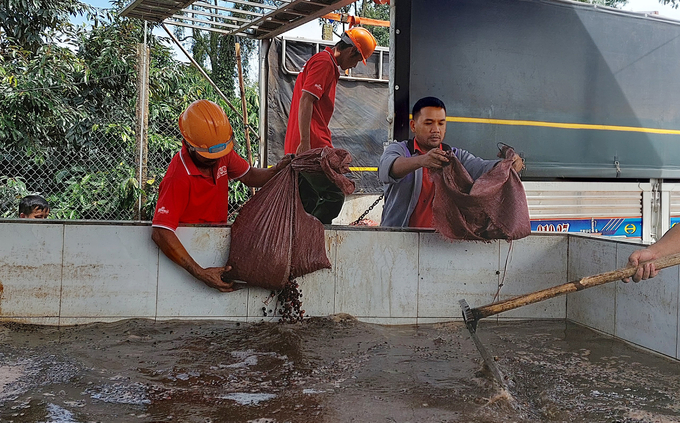
Vietnam has and follows numerous policies to encourage companies to invest in coffee processing. Picture: Minh Qui.
Authorities and companies will increase their investments, build and modernize processing plants, renew technological lines to improve quality and diversify products to meet customers’ increasing demands. export market. Improve product quality and variety, effectively implement coffee value chain to maintain, expand and grow export value to over $6 billion/year.
The orientation of the development of the agricultural sector for coffee up to 2030 in terms of scope, area, production and added value is based on the territorial space in order to promote irrigation in each region; Orientation towards production development related to 4.0 technology, digital transformation, digital economy; Development of the coffee processing and canning industry, development of logistics; Development of processing and export companies; Development of coffee related to tourism; Use of by-products to add value to industrial assets.
Bach Thanh Tuan, vice chairman of the Vietnam Coffee and Cocoa Association (VICOFA), said the coffee development project should review the context and direction by 2030 and complement international regulations that require demand for this industry.
Specifically, the EU currently stipulates that coffee products that come from the forest and harm the forests may not be imported. In particular, if the government is committed to reducing greenhouse gas emissions, the project must contain regulations on this topic. Only then will this industry contribute to the implementation of Vietnam’s commitments to the world.

